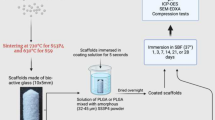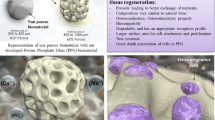Abstract
Bio-active glass has been developed for use as a bone substitute with strong osteo-inductive capacity and the ability to form strong bonds with soft and hard tissue. The ability of this material to enhance tissue in-growth suggests its potential use as a substitute for the dental laminate of an osteo-odonto-keratoprosthesis. A preliminary in vitro investigation of porous bio-active glass as an OOKP skirt material was carried out. Porous glass structures were manufactured from bio-active glasses 1-98 and 28-04 containing varying oxide formulation (1-98, 28-04) and particle size range (250–315 μm for 1-98 and 28-04a, 315–500 μm for 28-04b). Dissolution of the porous glass structure and its effect on pH was measured. Structural 2D and 3D analysis of porous structures were performed. Cell culture experiments were carried out to study keratocyte adhesion and the inflammatory response induced by the porous glass materials. The dissolution results suggested that the porous structure made out of 1-98 dissolves faster than the structures made from glass 28-04. pH experiments showed that the dissolution of the porous glass increased the pH of the surrounding solution. The cell culture results showed that keratocytes adhered onto the surface of each of the porous glass structures, but cell adhesion and spreading was greatest for the 98a bio-glass. Cytokine production by all porous glass samples was similar to that of the negative control indicating that the glasses do not induce a cytokine driven inflammatory response. Cell culture results support the potential use of synthetic porous bio-glass as an OOKP skirt material in terms of limited inflammatory potential and capacity to induce and support tissue ingrowth.









Similar content being viewed by others
References
Chirila TV, et al. Artificial cornea. Prog Polym Sci. 1998;23:447–73.
Langefeld S, Kompa S, Redbrake C, Brenman K, Kirchhof B, Schrage NF. Aachen keratoprosthesis as temporary implant for combined vitreoretinal surgery and keratoplasty: report on 10 clinical applications. Graefe’s Arch Clin Exp Ophthalmol. 2000;238:722–6.
Chirila TV. An overview of the development of artificial corneas with porous skirts and the use of PHEMA for such an application. Biomaterials. 2001;22:3311–7.
Kim MK, Lee JL, Wee WR, Lee JH. Seoul-type keratoprosthesis. Arch Ophthalmol. 2002;120:761–6.
Bruin P, Meeuwsen EAJ, van Andel MV, Worst JGF, Pennings AJ. Autoclavable highly cross-linked polyurethane networks in ophthalmology. Biomaterials. 1993;14:1089–97.
Pruitt LA. Fluorocarbon polymers in biomedical engineering. Encycl Mat Sci Tech. 2008;3216-21.
Renard G, Cetinel B, Legeais JM, Savoldelli M, Durand J, Pouliquen Y. Incorporation of a fluorocarbon polymer implanted at the posterior surface of the rabbit cornea. J Biomed Mat Res. 1996;31:193–9.
Caiazza S, Fanizza C, Mazziotti I, Pintucci S, Tomaino MA. Light and scanning electron microscopy evaluation of the Dacron felt as the haptic part of an improved keratoprosthesis. An in vitro and in vivo study. Clin Mat. 1988;3:33–40.
Trinkaus-Randall V, Capecchi J, Sammon L, Gibbons D, Leibowitz HM, Franzblau C. In vitro evaluation of fibroplasia in a porous polymer. Invest Ophthalmol Vis Sci. 1990;31:1321–6.
Trinkaus-Randall V, Banwatt R, Capecchi J, Leibowitz HM, Franzblau C. In vivo fibroplasia of a porous polymer in the cornea. Invest Ophthalmol Vis Sci. 1991;32:3245–51.
Kain HL. The development of the silicone-carbon keratoprothesis. Refract Corneal Surg. 1993;9:209–10.
Ciolino JB, Dohlman CH. Biologic keratoprosthesis materials. Int Ophthalmol Clin. 2009;49(1):1–9.
Miyashita H, et al. Collagen-immobilized poly(vinyl alcohol) as an artificial cornea scaffold that supports a stratified corneal epithelium. J Biomed Mat Res. 2006;76B:56–63.
Xie RZ, Sweeney DF, Beumer GJ, Johnson G, Griesser HJ, Steele JG. Effects of biologically modified surfaces of synthetic lenticules on corneal epithelialization in vivo. Aust N Z J Ophthalmol. 1997;25(Suppl):46–9.
Kobayashi H, Ikada Y. Corneal cell adhesion and proliferation on hydrogel sheets bound with cell-adhesive proteins. Curr Eye Res. 1991;10:899–908.
Pettit DK, Horbett TA, Hoffman AS, Chan KY. Quantitation of rabbit corneal epithelial cell outgrowth on polymeric substrates in vitro. Invest Ophthalmol Vis Sci. 1990;31:2269–77.
Ohji M, Mandarino L, SundarRaj N, Thoft RA. Corneal epithelial cell attachment with endogenous laminin and fibronectin. Invest Ophthalmol Vis Sci. 1993;34:2487–92.
Strampelli B. Osteo-odonto-keratoprosthesis. Ann Ottalmol Clin Ocul. 1963;89:1039.
Ricci R, Pecorella I, Ciardi A, Della RC, Di Tondo U, Marchi V. Strampelli’s osteo-odonto-keratoprosthesis. Clinical and histological long-term features of three prostheses. British J Ophthalmol. 1992;76:232–4.
Karlsson KH, Ylänen H, Aro H. Porous bone implants. Ceram Int. 2000;26:897–900.
Zhang D, Vedel E, Hupa L, Aro HT. Predicting physical and chemical properties of bio-active glasses from chemical composition. Part III. In vitro reactivity of glasses. Glass Tech Eur J Glass Sci Tech. 2009;50(1):1–8.
Hench LL, Andersson Ö. “Bio-active glasses” an introduction to bioceramics. In: Hench LL, Wilson J, editors. Advanced series in ceramics – vol. 1. Singapore: World Scientific; 1993.
Linnola RJ, Happonen RP, Andersson ÖH, Vedel E, Yli-Urpo AU, Krause U, Laatikainen L. Titanium and bio-active glass–ceramic coated titanium as materials for keratoprosthesis. Exp Eye Res. 1996;63:471–8.
Arstila H, Vedel E, Hupa L, Hupa M. Predicting physical and chemical properties of bio-active glasses from chemical composition. Part II. Devitrification characteristics. Glass Tech Eur J Glass Sci Tech. 2008;49(6):251–9.
Arstila H, Vedel E, Hupa L, Hupa M. Predicting physical and chemical properties of bio-active glasses from chemical composition. Part 2: Devitrification characteristics. Glass Tech Eur J Glass Sci Tech. 2009;49(6):260–5.
Lentner C. Geigy scientific tables, vol. 1. Units of measurements, Body fluid, Composition of body, and Nutrition. West Galdwell: Giba-Geigy; 1981.
Viitala R, Franklin V, Green D, Liu C, Lloyd A, Tighe B. Towards a synthetic osteo-odonto-keratoprosthesis. Acta Biomater. 2009;5:438–52.
Zhang D, Leppäranta O, Munukka E, Ylänen H, Viljanen MK, Eerola E, Hupa M, Hupa L. Antibacterial effects and dissolution behavior of six bio-active glasses. J Biomed Mat Res. doi: 10.1002/jbm.a.32564.
Hoppe A, Guldal NS, Boccaccini AR. A review of the biological response to ionic dissolution products from bio-active glasses and glass–ceramics. Biomaterials. 2011;32:2757–74.
Acknowledgments
Academy of Finland (Project no: 114117) is acknowledged for financial support. Jessica Alm is thanked for advice on cell culture on bio-active glasses.
Author information
Authors and Affiliations
Corresponding author
Rights and permissions
About this article
Cite this article
Huhtinen, R., Sandeman, S., Rose, S. et al. Examining porous bio-active glass as a potential osteo-odonto-keratoprosthetic skirt material. J Mater Sci: Mater Med 24, 1217–1227 (2013). https://doi.org/10.1007/s10856-013-4881-x
Received:
Accepted:
Published:
Issue Date:
DOI: https://doi.org/10.1007/s10856-013-4881-x




